 I think Pol Leurs (°1947, Luxemburg) was one of the first cartoonists I met in the ECC. In fact, without knowing whom he was in reality, I knew his cartoons long before I met Pol. Many of his cartoons are published in catalogues of the Knokke Heist Cartoon festival, and his cartoons always make me laugh in a particular way. Pol is a very amiable man and artist to meet. In fact he's a retired engineer and a self-taught cartoonist. He once told me that engineers may have some good qualities to be a cartoonist, as he refered to Yuriy Kosobukin, who studied engineering at univerity too and is a well-known cartoonist.
I think Pol Leurs (°1947, Luxemburg) was one of the first cartoonists I met in the ECC. In fact, without knowing whom he was in reality, I knew his cartoons long before I met Pol. Many of his cartoons are published in catalogues of the Knokke Heist Cartoon festival, and his cartoons always make me laugh in a particular way. Pol is a very amiable man and artist to meet. In fact he's a retired engineer and a self-taught cartoonist. He once told me that engineers may have some good qualities to be a cartoonist, as he refered to Yuriy Kosobukin, who studied engineering at univerity too and is a well-known cartoonist.
Take a look at Pol's cartoons at his website, and you'll be convinced a his qualities as an excellent cartoonist. Serving his incisive humor, his drawings are precise, accurate and meticulous. Acid humor sometimes speaks of his drawings who make one think, but ultimately find the approval of the audience.
His two books: Poleurs Cartoons 1 and 2 are proof of this. Unfortunetely the books are sold out, but in November this year, a third book will be published. I'm looking forward enjoying it!

 Learn more:
Learn more:Poleurs website
Poleurs on wikipedia
Cartoonbook files:

























